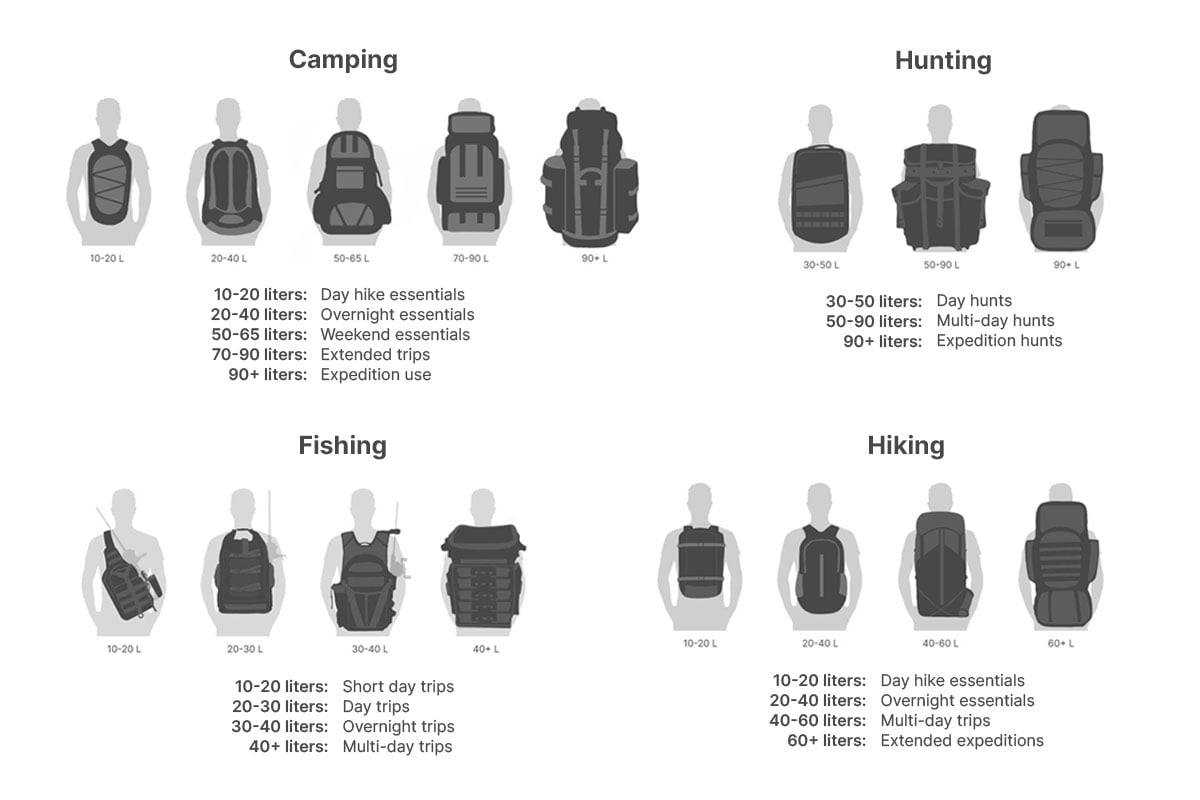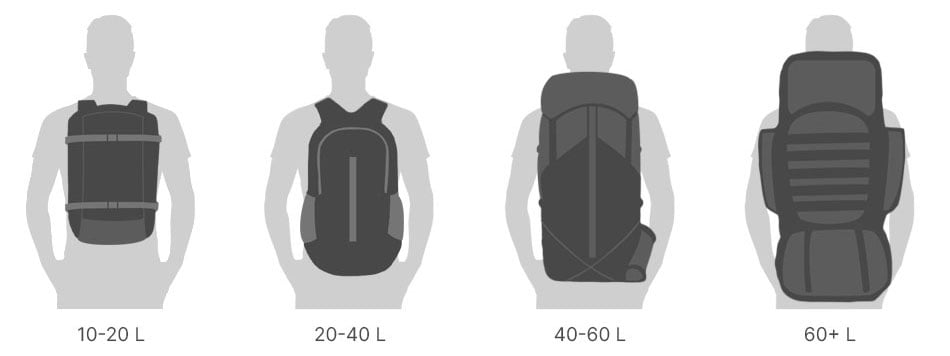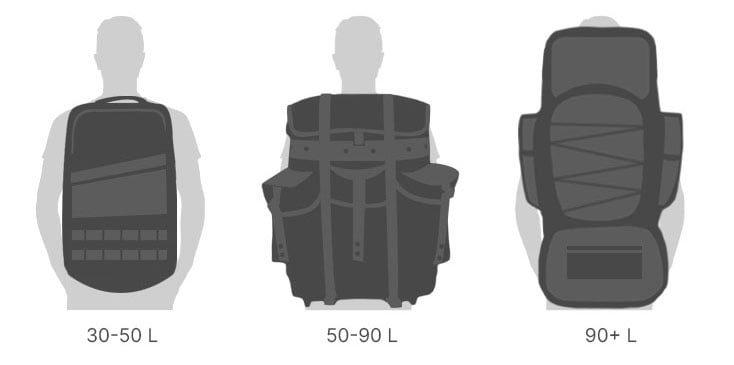Backpack Size Chart

Whether you’re exploring the outdoors a few hours or several days, every ounce you carry with you makes a difference. That’s why you need a backpack that is large enough for your gear and essentials, but not so large that you end up carrying around unnecessary weight from the pack itself.
If you know how much gear you need to carry, it can be helpful to lay it all out and see visually how much space you will need to carry it. But even as you are still assembling your gear, there are solid rules of thumb for backpack sizes for different activities. The following charts will help you determine the best backpack size for your next camping, hiking, hunting, or fishing trip.
Camping Backpack Sizes
If you are car camping, a small (10-20 L) backpack for essentials will improve your day hikes. If you are planning to carry all of your gear and essentials in your pack, the pack sizes are largely determined by the amount of time you’ll be traveling (and thus the amount of food you need to bring), and range from 20-90 L. Camping expeditions requiring specialty gear will require the largest packs (90+ L).

| Backpack Size (liters) | Use | Contents |
|---|---|---|
| 10-20 | Day hike essentials | Essentials such as hydration, snacks, maps, and a first-aid kit |
| 20-40 | Overnight essentials | Sleeping bag, a tent, stove, cookware, and food |
| 50-65 | Weekend essentials | Additional clothing, more food, and other camping gear |
| 70-90 | Extended trips | Additional food, gear for varying weather conditions, and additional safety supplies like a radio |
| 90+ | Expedition use | Expedition use may require equipment like specialized climbing gear, ropes, and tools |
Hiking Backpack Sizes
When you’re hiking, you always need to bring essentials like water, food, first aid, and navigation. A 10-20 L day pack will cover these essentials. The longer you’re hiking, and especially if you’ll be hiking overnight or for multiple nights, the larger you will need your pack to be. Overnight trips require 20-40 L, while multiday and extended trips will need 40-60+ L backpacking packs.

| Backpack Size (liters) | Use | Contents |
|---|---|---|
| 10-20 | Day hike essentials | Essentials like water, snacks, maps, rain gear, and a first-aid kit |
| 20-40 | Overnight essentials | Include extra clothing, a sleeping bag, maybe a small tent, camp stove, and adequate water capacity |
| 40-60 | Multi-day trips | Additional clothing, more food and water, a backpacking tent, sleeping pad, and possibly a filtration system |
| 60+ | Extended expeditions | Extended expeditions may require more specialized gear like crampons, ice axes, and sturdy backpacks with adequate suspension systems |
Hunting Backpacks
Hunters need all the same essentials as hiking (such as food, water, and navigation), plus crucial gear for the hunt itself, like ammunition and optics. This is why packs for day hunts will be significantly larger than those for day hikes, with a recommended 30-50 L hunting pack. If you’ll be sleeping outdoors over multiple days, or going on expeditions that require specialty gear, your pack will need to be larger still. Consider 50-90 L for multi-day hunts and even larger for expedition hunts.

| Backpack Size (liters) | Use | Contents |
|---|---|---|
| 30-50 | Day hunts | Ammunition, extra layers of clothing, hunting gloves, binoculars, or a small optics kit |
| 50-90 | Multi-day hunts | Additional food, clothing, hunting items—for example, a larger hunting knife, and camping essentials such as tents, sleeping bags, and fire starters |
| 90+ | Expedition hunts | Expedition hunts require carrying all necessary hunting equipment, specialized camping gear, and a full load of food and water |
Fishing Backpack Sizes
If you’re just popping out for a quick trip to the water, a 10-20 L fishing pack can carry your essentials and a small tackle box. A 20-30 L pack will help you carry more gear for a full-day trip. Overnight and multi-day trips will need more space for your shelter, with 30-40+ L recommended.

| Backpack Size (liters) | Use | Contents |
|---|---|---|
| 10-20 | Short day trips | Small tackle box, water bottle, snacks, sunscreen, insect repellent |
| 20-30 | Day trips | Medium tackle box, extra clothing, lunch, water bottle, sunscreen, insect repellent, first aid kit |
| 30-40 | Overnight trips | Large tackle box, sleeping bag, extra clothing, food, water, stove, cooking gear, tent |
| 40+ | Multi-day trips | Multiple tackle boxes, fishing rod, camping gear, food, water, cooking gear, tent, sleeping bag, extra clothing |
Note: Backpack size should also be determined by your body size/frame, strength, endurance and overall health. You never want to purchase a backpack that is going to create undue stress.